the ADHDe project
the ADHDe project by University of Windsor is licensed under a Creative Commons Attribution-NonCommercial 4.0 International License, except where otherwise noted.
University of Windsor
the ADHDe project by University of Windsor is licensed under a Creative Commons Attribution-NonCommercial 4.0 International License, except where otherwise noted.
1
The ADHDe Project is a student-led initiative that promotes inclusion and respect for university students who identify as neurodiverse.
This project was created to destigmatize ADHD and neurodiversity on campus, provide students with resources and support, and promote a welcoming environment at the University of Windsor.
Funded by the Government of Ontario, and in partnership with the Learning Disability Association of Windsor Essex (LDAWE), The ADHDe Project will host a series of social media campaigns, workshops, and seminars along with a permanent digital resource for people who identify as neurodiverse.
I
1
The following posters were developed for the first iteration of the ADHDe workshops and sessions. You can find the downloadable PDF versions at the bottom of this page.
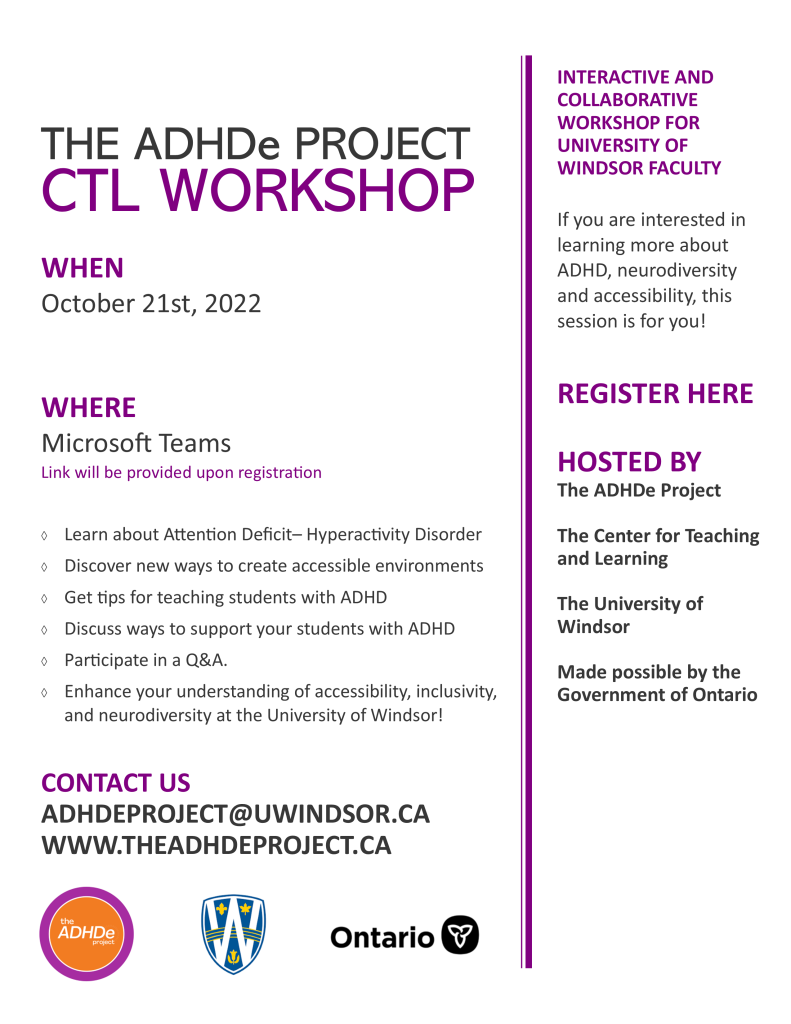
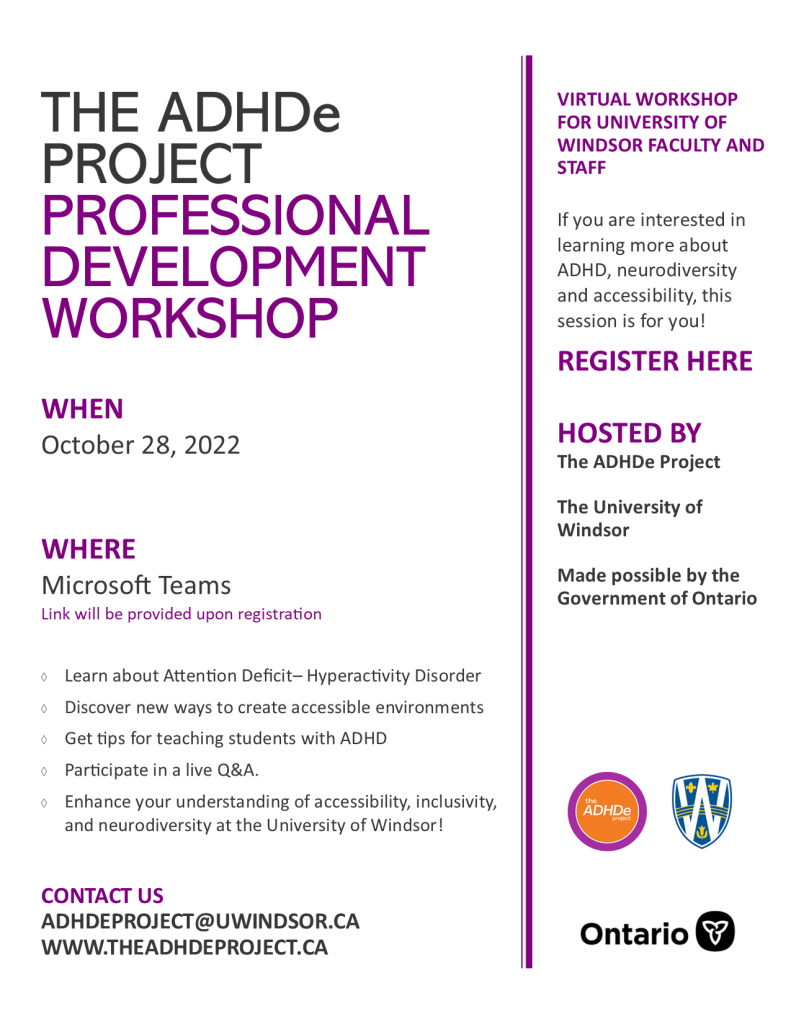
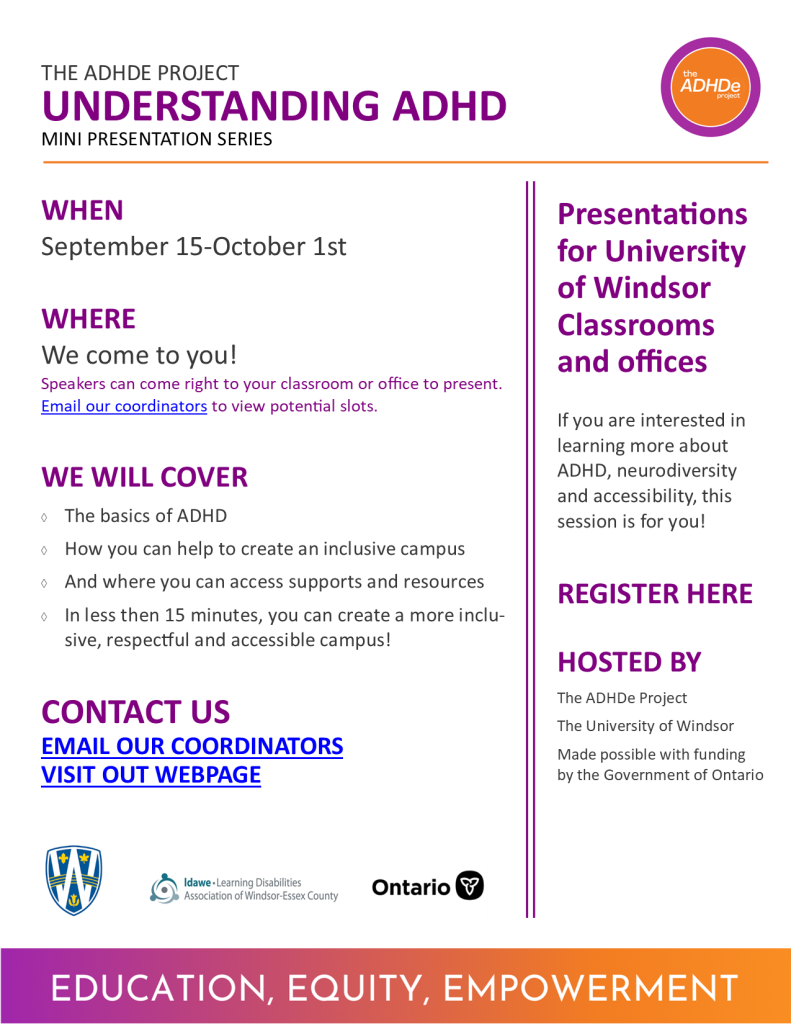
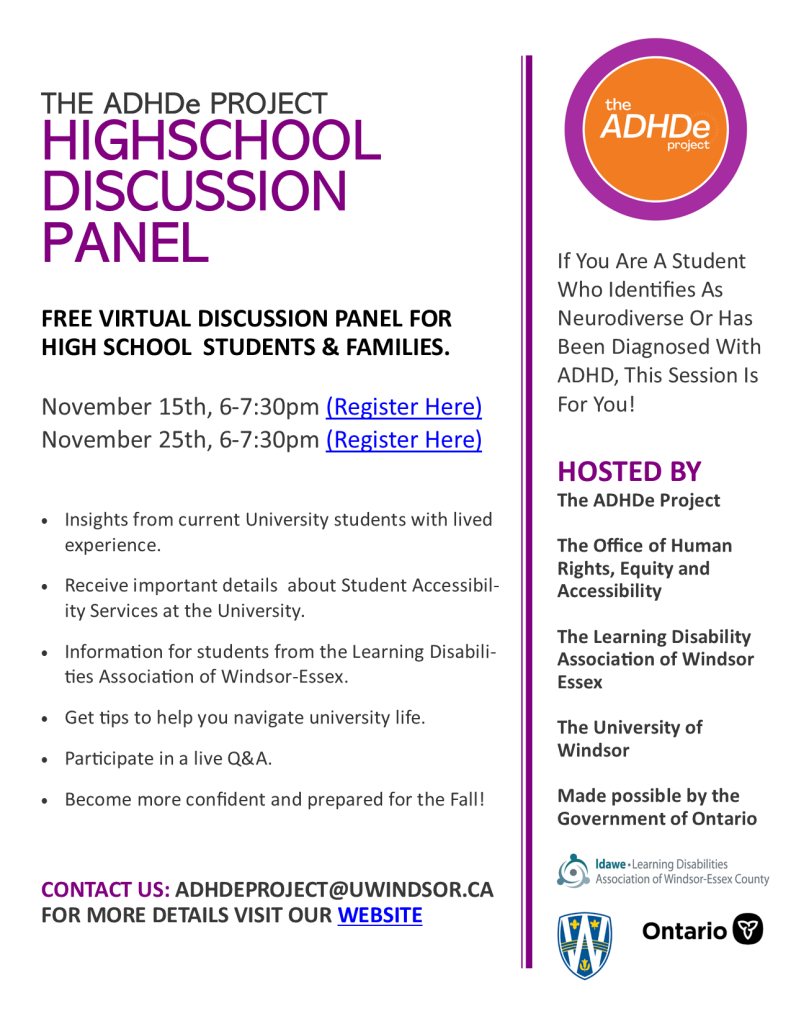
2
Bring The ADHDe Project into your classroom or office! In less than 15 minutes, you can create a more inclusive, respectful, and accessible campus. We will cover…
Contact us at adhdeproject@uwindsor.ca for more details about how you can get involved!
Are you interested in gaining a better understanding of ADHD and neurodiversity? Would you like to learn how to best support those with ADHD by enhancing your understanding of accessibility and inclusivity? If so, join The ADHDe Project on October 28, 2022, for a virtual workshop led by University of Windsor students. Gain valuable tips for supporting students with ADHD, learn more about diagnosis and resources, and participate in a live Q&A session. Our project and workshops aim to address and break down barriers for people diagnosed with ADHD.
What is ADHD? How do we support students with ADHD? What is it like to be a university student with ADHD? All of these questions (and more!) will be answered during this workshop. Join The ADHDe Project and The Center for Teaching and Learning for an interactive session geared towards educators who want to learn more about ADHD and neurodiversity. For more information about The ADHDe Project and our goals, please visit our website.
Join The ADHDe Project and The University of Windsor for a virtual discussion panel geared toward high school students who have been diagnosed with ADHD and their families! This session will help prepare prospective University of Windsor students with the tools they need to succeed at the post-secondary level.
Virtual Presentation Dates:
II
3
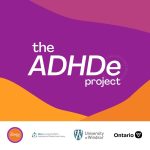
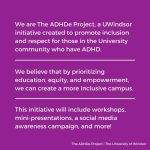
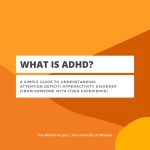

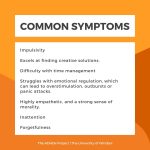

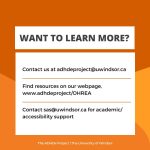
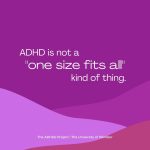
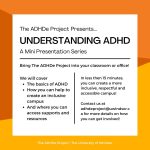
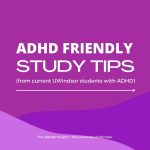
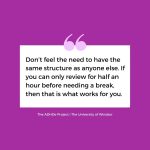
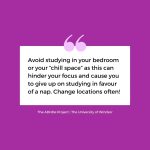

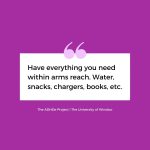
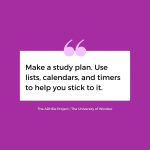

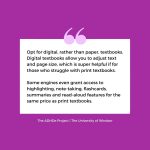
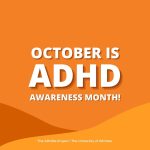
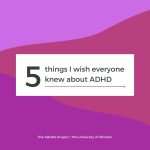
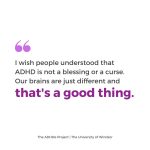



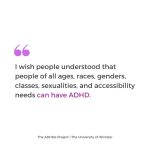
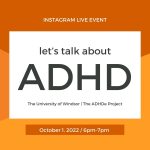

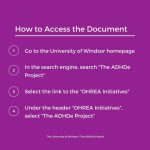

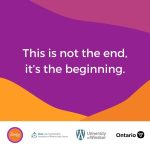
Hi! We’re The ADHDe Project! We know you’re busy and have a lot on your plate, but if you can give us approximately 45 seconds of your time we’d like to potentially change your life.
The ADHDe Project is a new University of Windsor initiative created to break down accessibility barriers on campus for people with ADHD and those who identify as neurodiverse.
We are…
We will be offering…
If you’re still reading it means we have gotten your attention. Here’s what comes next:
“ADHD/ADD: a developmental disorder that is marked especially by persistent symptoms of inattention (such as distractibility, forgetfulness, or disorganization)” …. blah, blah, blah please someone tell me I’m not the only one who is tired of this “one size fits all” definition for ADHD.
So, lets switch it up a bit.
ADHD: a neurodevelopmental disorder. Symptoms can include distractibility, impulsivity, and hyper fixation. May also result in daydreaming, brilliant problem-solving skills, getting “a pleasure to have in class” written on your elementary school report card, and constantly bouncing your knee when seated.
Truth be told, ADHD isn’t just a list of symptoms. It’s not just a piece of paper with a diagnosis, and it’s definitely not a synonym for lazy, stupid, or unmotivated.
If any of this is resonating with you, swipe through all the slides on todays post to learn more ADHD and the resources that are available for neurodiverse students on campus.
Need some support, some motivation, or just someone to talk to?
We’re here (arrow down emoji)
Few quick questions…
Yes? Maybe a little bit?
Believe it or not, these are all lesser-known symptoms of ADHD.
We’ve been taught to believe that ADHD has one face; the face of a little hyperactive kid who won’t behave in school. Not only does this stereotype represent an extremely small portion of the ADHD community, but it also leads us to believe that every person with ADHD needs to fit into that mold.
I can guarantee you; it is not a “one size fits all” disability.
Folks with ADHD: Do you have any random symptoms that don’t fit the traditional definition of ADHD?
The ADHDe Project Presents…
Understanding ADHD, A Mini Presentation Series!
Bring The ADHDe Project into your classroom or office for a short presentation on ADHD and accessibility. We will cover
In 15 minutes or less YOU can help to create a more inclusive campus!
Contact us at adhdeproject@uwindsor.ca to schedule your mini presentation.
Calling all students with ADHD (or anyone who needs some extra study tips), this post is for you!
With the beginning of a new semester, the inevitable midterm panic may be setting in for some of you. First things first, take a breath and relax your shoulders. You’re going to be ok; I promise. Here’s how:
Need some more ideas on how to conquer your midterm stress? Swipe through all the slides for some suggestions from current UWindsor students with ADHD!
Welcome to ADHD awareness month!
Every October, ADHDawarenessmonth.org celebrates people with ADHD and raises awareness through themed campaigns, workshops, and events. This year the theme is “Understanding A Shared Experience”.
In honour of ADHD awareness month, The ADHDe Project wants to acknowledge every person who has ADHD, regardless of diagnosis, gender, race, or religion. Although our brains may function in a similar way, we all experience our ADHD differently. Understanding how to support one another equitably while celebrating our individuality is important, and there’s no better time to start then now!
For more information on ADHD awareness month, head to adhdawarenessmonth.org.
We asked a group of current UWindsor students with lived experience what they wish everyone knew about ADHD.
Here’s what they had to say.
Swipe for more things we wish everyone knew about ADHD!
We’re going live! 🎉
The ADHDe Project will be hosting an open discussion on TBD, 2022, on Instagram Live.
This panel will be led by our project coordinators and will include a panel of students who will share their personal experiences with ADHD, as well as general awareness information.
Can’t wait to see you there!
To be honest, finding legitimate ADHD resources can be a pain. There’s a ton of info to search through, stuff is disorganized, and it’s rarely written in plain language.
You’d think that the people publishing the resources would have a better understanding of their target audience…
To make things easier, we’ve compiled a list of our favorite ADHD resources, that are also ADHD friendly.
Swipe through the slides for instructions on how to access the resource list (as well as some of our favourite Instagram resources) and let us know in the comments if you have any to add!
This is not the end, it’s the beginning.
The beginning and continuation of an important conversation.
The beginning of a more accessible campus.
The beginning of new connections and relationships that were built through this campaign.
The ADHDe Project would like to thank (insert page name here), as well as all of the other groups that have volunteered their platform over the last several weeks.
Be sure to check out our website, https://www.uwindsor.ca/ohrea/212/adhde-project, to learn more about our upcoming events!
III
4
One or more interactive elements has been excluded from this version of the text. You can view them online here: https://ecampusontario.pressbooks.pub/adhde/?p=46
This guide was created to act as a map for this presentation. Please note that all of the script is suggested. We encourage you to add your own personal touch! You may download a copy of the PowerPoint file below, or download a copy of the above H5P presentation by clicking “Reuse” at the bottom of the presentation.
The ADHDe Project is a student-led initiative that promotes inclusion and respect for students (especially those at the post-secondary level) who have been diagnosed with ADHD or identify as neurodiverse. This project was created to destigmatize ADHD and neurodiversity on campus, provide students with resources and support, and promote a welcoming environment at the University of Windsor. We recognize how difficult navigating university life can be for anyone, and sometimes more so for students who identify as neurodiverse or have ADHD. The ADHDe Project was produced by The University of Windsor and The Learning Disabilities Association of Windsor Essex with support from the Government of Ontario.
The ADHDe Project was made possible by a grant from The EnAbling Change Program. The goals of the EnAbling Change Program are to encourage education about accessibility and encourage awareness about its benefits.
The EnAbling Change Program is a grant program run by the Ministry for Seniors and Accessibility. Thanks to the support from the EnAbling Change Program, The ADHDe Project was able to become a university wide accessibility initiative.
When discussing accessibility and inclusion in Ontario, it is important to discuss the OHR and the AODA. Educational institutions in Ontario have an obligation to adhere to two sets of regulations, the Ontario Human Rights code (OHR) and the Accessibility for Ontarians with Disabilities Act (AODA).
Attention Deficit/ Hyperactivity Disorder (ADHD) is often defined as a neurodevelopmental disorder. Common symptoms include:
Many people with ADHD excel at creative problem solving, are exceptionally empathetic, and often have a strong sense of fairness. There are three ways ADHD can present.
Here are some examples of the most common Inattentive Type and Hyperactive Type symptoms.
Common Hyperactive Type Symptoms:
As with many people with disabilities, people with ADHD may experience an increase of barriers in their day-to-day life. Here are some examples of these barriers:
You may be thinking to yourself, why does this matter? This doesn’t affect me or any of my friends or family, so what’s the big deal?
ADHD may be more relevant to your life then you think. According to the Center for ADHD Awareness, Canada, at least 5% of people worldwide have ADHD. Likely, that number is much higher.
Even if it may not affect you personally, we hope that everyone at the University believes that people with ADHD deserve to have the opportunity to experience an accessible and respectful campus.
And although you may not see it right away, accessible spaces and practices benefit everyone! Wouldn’t it be nice to have access to meeting notes or lecture slides ahead of time so that you could easily prepare for your session? Or how about having the opportunity to learn in a non-traditional style without being judged?
Accessibility is a word that gets used a lot these days. But what does it actually mean? And how do we use accessible practices in our day-to-day lives?
Creating accessible spaces for people with ADHD can be challenging because ADHD is what we commonly refer to as an “invisible disability”. This means that when you first meet someone you may not be able to tell that they have ADHD.
Because of that, people with ADHD may have a difficult time working, learning, and socializing in places designed for people without ADHD. Here are some suggestions to help create a more accessible and respectful place for all people.
If you are a student at the University of Windsor who has been diagnosed with ADHD, you are entitled to certain accessibility accommodations. You don’t have to do this alone!
University can be really challenging, and you deserve the proper supports and resources that will help you to do your best.
You can connect with Student Accessibility Services to learn more about the supports that are available, we will have their contact information posted on the last slide.
If you are interested in learning more about ADHD, we recommend checking out the Center for ADHD Awareness, Canada, and the Canadian ADHD Resource Alliance. They both have some wonderful resources that can help further your understanding of ADHD and neurodiversity. If you’re interested in learning more about The ADHDe Project, please visit our website or feel free to send us an email at adhdeproject@uwindsor.ca.
We appreciate your time, and we hope that everyone has a lovely day!
5
One or more interactive elements has been excluded from this version of the text. You can view them online here: https://ecampusontario.pressbooks.pub/adhde/?p=48
This guide was created act as a map for this presentation. Please note that all of the script is suggested. We encourage you to add your own personal touch!
Before we begin our workshop today, we would likely to briefly discuss the rules of engagement for this session. Fostering a supportive learning environment is a shared responsibility.
(Make amendments as needed)
Before we jump in, here is a brief overview of what we will be covering today!
The ADHDe Project is a student-led initiative that promotes inclusion and respect for students (especially those at the post-secondary level) who have been diagnosed with ADHD or identify as neurodiverse. This project was created to destigmatize ADHD and neurodiversity on campus, provide students with resources and support, and promote a welcoming environment at the University of Windsor. We recognize how difficult navigating university life can be for anyone, and sometimes more so for students who identify as neurodiverse or have ADHD.
The ADHDe Project was produced by The University of Windsor and The Learning Disabilities Association of Windsor Essex with support from the Government of Ontario.
The name The ADHDe Project represents the three “e’s” of our mission, Education, Equity and Empowerment. We believe that by amplifying the voices of people with ADHD we will be able to create a more inclusive and accessible campus.
The ADHDe Project was made possible by a grant from The EnAbling Change Program, a grant program run by the Ministry for Seniors and Accessibility. Thanks to the support from the EnAbling Change Program, The ADHDe Project was able to become a university-wide accessibility initiative.
When discussing accessibility and inclusion in Ontario, it is important to mention the AODA.
The AODA (The Accessibility for Ontarians with Disabilities Act) is an Ontario law which mandates that organizations must follow certain accessibility standards. The Act was put into place in 2005, with the intention of creating a fully accessible Ontario by 2025. There are currently five standards in place:
The goal of the AODA is to help organizations provide an accessible experience for all Ontarians. Please note that there are two additional standards in the progress of development: the Health Care Standards and the Educational Standards.
To help everyone feel comfortable and informed about the topics we’ll be covering today we will start by discussing some of the concepts and terms that are key to this project. We hope that these carefully defined concepts and terms will give you a better understanding of the barriers, circumstances, and realities that students with ADHD experience.
Now, we will discuss some of the terminology associated with ADHD and neurodiversity.
There has been a shift in ADHD terminology and labelling. Sometimes controversial. As a team we worked together to present an equitable and inclusive understanding of ADHD.
Now that we’ve gone over the different ways that ADHD presents itself, let’s go over some examples of the most common symptoms.
Common Inattentive Type Symptoms:
Common Hyperactive Type Symptoms:
When discussing ADHD, it is important that we think about intersectionality.
Intersectionality is a concept made known by Kimberlé Crenshaw.
It acknowledges that everyone has their own unique experiences, and their identities play a role in how they experience the world.
Because of that, it’s important to take into consideration how a person’s identities may intersect with one another.
Some examples of intersecting identities may include:
For example, women with ADHD are less likely to be diagnosed with ADHD than their male peers. Women are often diagnosed later in life and often struggle to receive accessibility accommodations and support.
Before we look at the benefits and challenges of an ADHD diagnosis, are there any questions?
A big part of understanding ADHD and how to support people with ADHD is learning about the diagnosis process. Obtaining a diagnosis can help individuals with ADHD better understand their circumstances. The absence of diagnosis may leave people wondering why they:
After receiving a diagnosis, the individual is then able to reap the benefits. Diagnosis also helps to obtain qualification for resources and supports. This includes access to supports such as mental health supports, academic accommodations, medications, and familial support.
It is important to understand that there are many potential barriers to getting an ADHD diagnosis. These are barriers in place that make it difficult to receive a diagnosis and may discourage people from pursuing support.
Unfortunately, the barriers experienced during the diagnosis process is only the tip of the iceberg. After being diagnosed with ADHD there are many potential challenges that a person may face because of their diagnosis.
One of these barriers is stigma, which is a negative stereotype about a person or group of people. The stigmatization of ADHD is relevant in every aspect of society. ADHD stigma can create challenges in education, work, and social settings. It’s also important to note that social stigma can lead to self-stigma which can be limiting as it promotes negative self-views and associations with their diagnosis. The severity of stigma can be placed on a continuum depending on the individual’s intersecting identifying factors (gender, race, ethnicity, religion, age, etc.).
So, what comes next? Now that we know the struggles that individuals with ADHD may face, how do we support them?
Considering the external and internal struggles that people with ADHD can face, it’s no surprise that many experience depression, anxiety, and self-doubt. By age 10, it’s estimated that children with ADHD have received 20,000 more negative messages than positive ones. (Source: attitude magazine). That is why inclusive and accessible spaces are so important. People with ADHD deserve to feel as supported and valued as everyone else, and it’s up to all of us to help foster those spaces. Creating an inclusive space is key for helping people with ADHD thrive. This also encourages everyone to be more aware of how their actions may impact others and creates an environment that models’ inclusivity.
ADHD is commonly referred to as an “invisible disability”. This means that when you first meet someone you may not be able to tell that they have ADHD. Because of that, people with ADHD may have a difficult time working, learning, and socializing in places designed for people without ADHD. Here are some suggestions to help create a more accessible and respectful place for all people.
Promoting and creating an inclusive space helps to ease potential anxieties and worries that students may have. Inclusivity should be approached with a wide lens, with the goal of encouraging all identities to thrive and feel comfortable doing so. Here are some tips on how you can create a more inclusive environment for people with ADHD:
We would like to thank everyone for their attendance and participation in this workshop thus far! Before we finish up for today, we’d like to take a moment to review some of the information we discussed today, as well as look ahead at some of the ADHD friendly practices that can be implemented right away.
In a nutshell, here is what we covered today.
Going forward, here are some of the things you can do to help make your office, department, and social environment more accessible and respectful for people with ADHD. Firstly, approach ADHD with curiosity. If ADHD is a new topic for you, that’s ok! Creating inclusive spaces is not about knowing every little detail, it’s about being open to learning new things, and treating people with respect. Secondly, try not to make assumptions. The people in your lives with ADHD will rarely look like the stereotypes you see in the media. Thirdly, even if they haven’t disclosed it, you likely know people with ADHD. When discussing ADHD and neurodiversity, be conscious that the words you use matter. You never know what the person you’re speaking to may be experiencing, so always keep it respectful.
We would like the thank The OHREA for their support with this workshop and initiative, as well as The Learning Disabilities Association of Windsor-Essex, The University of Windsor, and the Government of Ontario. Most importantly, we would like to thank all of our attendees for being here today. Please feel free to contact us via email at any time or visit our website for more project updates and announcements.
6
One or more interactive elements has been excluded from this version of the text. You can view them online here: https://ecampusontario.pressbooks.pub/adhde/?p=50
This guide was created act as a map for this presentation. Please note that all of the script is suggested. We encourage you to add your own personal touch!
Before we begin our workshop today, we would likely to briefly discuss the rules of engagement for this session. We believe that fostering a supportive learning environment is a shared responsibility, and here are some ways we can all contribute to the creation of this space.
(Make amendments as needed)
(Minion Simulation Activity) Play video without introduction.
Hello and welcome to the session. Thank you for taking the time out of your days to be here today. Before I explain what you just experienced, I’ll start with an introduction: My name is ______ and my pronouns are _____ (amend script to accommodate number of facilitators).
By a show of hands, how many people understood what was happening in that video? (Pause to view raised hands).
Perfect, thank you. Raise your hand if you feel uncomfortable or awkward in this room? (Pause to view raised hands?).
Ok, thank you. Now, imagine this. Imagine you’ve been sitting in this room for three, four, five, plus hours. You’re feeling confused and embarrassed because you don’t understand what you’re looking at, you’re distracted by the relentless buzzing sounds, and you don’t know why everyone else seems to know what they’re doing (pause).
If you were in this environment, do you think you’d be able to achieve academic excellence? For many students, this is what everyday classroom life may feel like. Except for students with ADHD, it isn’t a simulation. They don’t always have the luxury of turning off the distracting background noises or being able to attend a lecture that is presented in a way that makes sense to them. Now that we’ve set ourselves in this mindset, let’s see what we can do to make this workshop more accessible. We can start by turning off the background noise! (Pause and turn off background noise).
Next let’s all adjust our physical space and turn our chairs forward. Finally, lets acknowledge the elephant in the room… unless anyone is fluent in minion speak, we need to change our way of communication to a more accessible format.
We started with this “ADHD simulation” activity to demonstrate the potential challenges that students may face and to help illustrate some of the accessibility accommodations that can make classroom learning more inclusive.
Take a moment to consider the following questions:
Please take 30 seconds to think about these questions. (Pause for 30 seconds). We invite you to share with the person or people you’re seated next to, to share your thoughts. We will rejoin as a group in 2 minutes. (Pause for two minutes). Thank you everyone. Is there anyone who would like to briefly share what they discussed in their group? (Allow 3-4 minutes for sharing).
Thank you for sharing! We encourage you to keep these questions in mind as we continue with our session today.
Before we jump in, here is a brief overview of what we will be covering today!
The ADHDe Project is a student-led initiative that promotes inclusion and respect for students (especially those at the post-secondary level) who have been diagnosed with ADHD or identify as neurodiverse. This project was created to destigmatize ADHD and neurodiversity on campus, provide students with resources and support, and promote a welcoming environment at the University of Windsor. We recognize how difficult navigating university life can be for anyone, and sometimes more so for students who identify as neurodiverse or have ADHD.
The ADHDe Project was produced by The University of Windsor and The Learning Disabilities Association of Windsor Essex with support from the Government of Ontario.
The name The ADHDe Project represents the three “e’s” of our mission, Education, Equity and Empowerment. We believe that by amplifying the voices of people with ADHD we will be able to create a more inclusive and accessible campus.
The ADHDe Project was made possible by a grant from The EnAbling Change Program, which is a grant program run by the Ministry for Seniors and Accessibility. The goals of the EnAbling Change Program are to encourage education about accessibility and encourage awareness about its benefits. Thanks to the support from the EnAbling Change Program, The ADHDe Project was able to become a university-wide accessibility initiative.
When discussing accessibility and inclusion in Ontario, it is important to mention the AODA.
Educational institutions in Ontario have an obligation to adhere to two sets of regulations, the Ontario Human Rights Code (OHRC) and The Accessibility for Ontarians with Disabilities Act (AODA). The OHRC: Mandating accessible, inclusive, discrimination and harassment-free education environments that support human rights.
AODA: The AODA established the Integrated Accessibility Standard Regulations (IASR), a grouping of legal requirements that institutions must follow to help identity, remove, and prevent barriers faced by persons with disabilities. These requirements are divided into two categories: General Requirements and Accessibility Standards. The Act was put into place in 2005, with the intention of creating a fully accessible Ontario by 2025.
Brainstorming activity: What are some key words that come to mind when you think about ADHD?
To help everyone feel comfortable and informed about the topics we’ll be covering today we will start by discussing some of the concepts and terms that are key to this project. We hope that these carefully defined concepts and terms will give you a better understanding of the barriers, circumstances, and realities that students with ADHD experience.
Now, we will discuss some of the terminology associated with ADHD and neurodiversity.
There has been a shift in ADHD terminology and labelling. Sometimes controversial. As a team we worked together to present an equitable and inclusive understanding of ADHD.
Now that we’ve gone over the different ways that ADHD presents itself, let’s go over some examples of the most common symptoms.
Common Inattentive Type Symptoms:
Common Hyperactive Type Symptoms:
When discussing ADHD, it is important that we think about intersectionality.
Intersectionality is a concept made known by Kimberlé Crenshaw.
It acknowledges that everyone has their own unique experiences, and their identities play a role in how they experience the world.
Because of that, it’s important to take into consideration how a person’s identities may intersect with one another.
Some examples of intersecting identities may include:
For example, women with ADHD are less likely to be diagnosed with ADHD than their male peers. Women are often diagnosed later in life and often struggle to receive accessibility accommodations and support.
Before we look at the benefits and challenges of an ADHD diagnosis, are there any questions?
A big part of understanding ADHD and how to support people with ADHD is learning about the diagnosis process. Obtaining a diagnosis can help individuals with ADHD better understand their circumstances. The absence of diagnosis may leave people wondering why they:
After receiving a diagnosis, the individual is then able to reap the benefits. Diagnosis also helps to obtain qualification for resources and supports. This includes access to supports such as mental health supports, academic accommodations, medications, and familial support.
It is important to understand that there are many potential barriers to getting an ADHD diagnosis. These are barriers in place that make it difficult to receive a diagnosis and may discourage people from pursuing support.
Unfortunately, the barriers experienced during the diagnosis process is only the tip of the iceberg. After being diagnosed with ADHD there are many potential challenges that a person may face because of their diagnosis.
One of these barriers is stigma, which is a negative stereotype about a person or group of people. The stigmatization of ADHD is relevant in every aspect of society.
ADHD stigma can create challenges in education, work, and social settings. It’s also important to note that social stigma can lead to self-stigma which can be limiting as it promotes negative self-views and associations with their diagnosis.
The severity of stigma can be placed on a continuum depending on the individual’s intersecting identifying factors (gender, race, ethnicity, religion, age, etc.).
Once potential employers, colleagues or friends discover you have ADHD they may make assumptions based on what they’ve seen in the media. They may assume you are going to be unreliable, lazy, less intelligent, a distraction or uncommitted.
Lack of Support and Misunderstanding of ADHD and Neurodiversity: a lack of understanding lends itself to a lack of support for people who have ADHD and/or identify as neurodiverse.
These misunderstandings and lack of support creates additional barriers to achieving academic, professional, and social goals.
Medication, therapy and receiving a diagnosis can all be expensive and difficult to access.
Along with the social and academic barriers that people with ADHD may experience, they may also experience the following:
This can make it very difficult for a person with ADHD to thrive (or even survive). Understanding how challenging the day-to-day life of someone with ADHD can be is hugely important to creating accessible and respectful environments.
Nadia’s lived experience
So, what comes next? Now that we have a better idea of what students with ADHD may face, how do we support them?
Depending on your previous experience, you may or may not have had the opportunity to work with a student who has ADHD. Our goal today is to provide you with the tools you’ll need to support your students as best as you can. One of those tools is knowing how to take an inaccessible situation and make it accessible. Let’s do a quick brainstorm together to see if we can think of some ways to support students with ADHD. Question 1: What are some general accessibility recommendations for the classroom? Question 2: What are some inaccessible things you may see in the classroom? (Allow 3-5 minutes for group brainstorm session). Thank you, everyone for your participation!
As we begin to discuss the ways that educators can implement accessible practices into their teaching, let’s look at the principals of universal design. We’re sure this is a concept that many of you have encountered before, so we will just do a brief overview. Essentially, the principals of universal design were put forth in 1997 to help guide the design process in an accessible way. Many of these principals can be taken into consideration when in a classroom setting, especially when working with students who have ADHD or identify as neurodiverse. These principals are:
Considering the external and internal conflicts that people with ADHD can face, it’s no surprise that many experience depression, anxiety, and self-doubt.
By age 10, it’s estimated that children with ADHD have received 20,000 more negative messages than positive ones. (Source: attitude magazine). That is why inclusive and accessible spaces are so important.
People with ADHD deserve to feel as supported and valued as everyone else, and it’s up to all of us to help foster those spaces.
Creating an inclusive space is key for helping people with ADHD thrive. This also encourages other students to be more aware of how their actions impact their peers and creates an environment that models’ inclusivity.
We understand that this may all seem a little bleak, but it’s important to remember that you can make a difference! As an educator, you are crucial to a student’s learning experience. By implementing simple practices, you can make the world of difference for a student with ADHD.
When it comes to supporting someone with a disability a little truly can go a long way, and it all boils down to education and awareness. When you know better, you do better.
ADHD is commonly referred to as an “invisible disability”. This means that when you first meet someone you may not be able to tell that they have ADHD. Because of that, people with ADHD may have a difficult time working, learning, and socializing in places designed for people without ADHD. Here are some suggestions to help create a more accessible and respectful place for all people.
Promoting and creating an inclusive space helps to ease potential anxieties and worries that students may have. Inclusivity should be approached with a wide lens, with the goal of encouraging all identities to thrive and feel comfortable doing so.
Here are some tips on how you can create a more inclusive environment for people with ADHD:
Education is the backbone of a developing and progressive society. It is important for educators to recognize that students’ educational needs are diverse.
It is important that accessible learning materials are developed in a way that supports the diverse needs of students.
Creating an inclusive space gives all students a voice, a purpose, and a better sense of contribution to the learning environment.
Here are some tips on how to create a supportive learning environment for students with ADHD:
We would like to thank everyone for their attendance and participation in this workshop thus far! Before we finish up for today, we’d like to take a moment to review some of the information we discussed today, as well as look ahead at some of the ADHD friendly practices that can be implemented right away.
In a nutshell, here is what we covered today.
Going forward, here are some of the things you can implement in your classroom to make it a more accessible and inclusive space for your students.
Thank you for your participation!
We would like the thank The Center for Teaching and Learning for their support with this workshop and initiative, as well as The Learning Disabilities Association of Windsor-Essex, The University of Windsor, and the Government of Ontario. Most importantly, we would like to thank all our attendees for being here today. Please feel free to contact us via email at any time or visit our website for more project updates and announcements.
7
One or more interactive elements has been excluded from this version of the text. You can view them online here: https://ecampusontario.pressbooks.pub/adhde/?p=52
The ADHDe Project is a student-led initiative that promotes inclusion and respect for students (especially those at the post-secondary level) who have been diagnosed with ADHD or identify as neurodiverse. This project was created to destigmatize ADHD and neurodiversity on campus, provide students with resources and support, and promote a welcoming environment at the University of Windsor. We recognize how difficult navigating university life can be for anyone, and sometimes more so for students who identify as neurodiverse or have ADHD. The ADHDe Project was produced by The University of Windsor and The Learning Disabilities Association of Windsor Essex with support from the Government of Ontario.
The name The ADHDe Project represents the three “e’s” of our mission; education, equity and empowerment. We believe that by amplifying the voices of people with ADHD we will be able to create a more inclusive and accessible campus.
The ADHDe Project was made possible by a grant from The EnAbling Change Program. The goals of the EnAbling Change Program are to encourage education about accessibility and encourage awareness about its benefits.
The EnAbling Change Program is a grant program run by the Ministry for Seniors and Accessibility. Thanks to the support from the EnAbling Change Program, The ADHDe Project was able to become a University wide accessibility initiative.
Every post secondary institution in Ontario is required to adhere to certain accessibility standards. Knowing that these regulations exist is important because it will help you to understand the rights you have as students. There are two different accessibility regulations that we’ll be covering today, the OHRC and the AODA.
Educational institutions in Ontario have an obligation to adhere to two sets of regulations, the Ontario Human Rights code (OHR) and the Accessibility for Ontarians with Disabilities Act (AODA).
The goals of the OHRC is to help maintain accessible, inclusive, discrimination and harassment-free education environments that respect human rights.
The AODA: The AODA established the Integrated Accessibility Standard Regulations (IASR), a grouping of legal requirements that institutions must follow to help identify, remove, and prevent barriers faced by persons with disabilities. These requirements are divided in two categories: General Requirements and Accessibility Standards. The Act was put into place in 2005, with the intention of creating a fully accessible Ontario by 2025.
The goal of the AODA is to help organizations provide an accessible experience for all Ontarians. Please note that there are two additional standards in the progress of development: the Health Care Standards and the Educational Standards.
Thank You Thank you for participating! We will now be opening the floor up for questions. Please feel free to type your questions in the chat, or you can raise your hand.
IV
Please note that this guide will be updated regularly with new resources. If you have the link to a new resource that is not currently in the guide, please feel free to send it to us via email at adhdeproject@uwindsor.ca. For more information about The ADHDe Project, please visit our website.
Resource/organization |
Website |
Description |
| Center for ADHD Awareness, Canada | https://caddac.ca/ | Canadian charity providing resources and support for people with ADHD. |
| Canadian ADHD Resource Alliance | https://www.caddra.ca/ | Not for profit organization for medical, research, and healthcare professionals with an interest in ADHD. |
| ADDitude | https://www.additudemag.com/ | Magazine that publishes articles about ADHD. |
| ADHD Awareness Month Organization | https://www.adhdawarenessmonth.org/ | Official organizers of ADHD Awareness Month |
| General ADHD Resource List | https://www.coulditbeadhd.ca/adhd-resources | “Could it be ADHD” general resource list. |
| Talking About ADHD guide | https://www.caddra.ca/wp-content/uploads/Copy-of-ADHD-Language-Guide-Infographic_DEC2021_CADDRA.pdf | CADDRA infographic. Provides info on how to discuss ADHD. |
Resource/organization |
How to access |
Description |
| EduMed | https://www.edumed.org/resources/college-students-with-adhd/ | Resources for college students with ADHD |
| The Best Schools Article | https://thebestschools.org/resources/10-study-tips-add-adhd-students/ | 10 study tips for student with ADHD |
| University of Manitoba Student Wellness Blog Post | Intersectionality: My Thoughts As A Female Student Recently Diagnosed With ADHD (healthyuofm.com) | Female post-secondary student with ADHD reflects on her recent diagnosis. |
Resource/organization |
How to access |
Description |
| The ADHDe Project | https://www.uwindsor.ca/ohrea/212/adhde-project | University of Windsor initiative created to destigmatize ADHD on campus. |
| Office of Human Rights, Equity, and Accessibility | https://www.uwindsor.ca/ohrea/15/about-ohrea | UWindsor service |
| Student Accessibility Services | https://www.uwindsor.ca/studentaccessibility/ | UWindsor student service |
| Student Counselling Center | https://www.uwindsor.ca/wellness/304/counselling | UWindsor student service |
| Student Health Services | https://www.uwindsor.ca/wellness/327/health-services | UWindsor student service |
| Executive Functioning Group | https://www.uwindsor.ca/wellness/311/groups | Campus group that supports students with ADHD |
| ADHD Coach | https://www.uwindsor.ca/studentaccessibility/297/student-information | Campus ADHD coach |
Resource/organization |
How to access |
Description |
| Canadian Mental Health Association, Ontario | https://ontario.cmha.ca/provincial-mental-health-supports/ | Canadian help lines, mental health resources, and Covid-19 related resources. |
| Bounce Back Ontario | https://bouncebackontario.ca/ | Free, self-guided skill building program for those age 15+. |
Resource/organization |
How to access |
Description |
| Time Management Fact Sheet | https://chadd.org/wp-content/uploads/2018/05/Time-Management-ADHD-Day-Planners.pdf | Information sheet with tips on how to use a daily planner. Created by CHADD. |
| Attention Deficit Disorder Alliance Resource Page | https://add.org/start/adda-resources/ | Tips, free courses, articles etc. on ADHD management for adults |
Resource/organization |
How to access |
Description |
| Kaleidoscope Society | https://www.kaleidoscopesociety.com/ | Online community that supports and empowers women with ADHD. Website has articles, resources, interviews, etc. |
| Adulting With ADHD | https://adultingwithadhd.com/adhd-in-women/ | Podcast about ADHD and women |
| Kaiser Health News Article | https://khn.org/news/article/black-women-adhd-attention-deficit-hyperactivity-disorder-underdiagnosed/amp/ | Article about Black women with ADHD |
| The Children Left Behind, ADDitude Article | Race and ADHD: How People of Color Get Left Behind (additudemag.com) | Article about children with ADHD going undiagnosed due to their race or ethnicity. |
| Culturally Competent Approaches to ADHD, Psychiatric Times article | Culturally Competent Approaches to ADHD: Issues in African-American Populations (psychiatrictimes.com) | Medical article about the intersection of ADHD and African American identity. |
Resource/organization |
How to access |
Description |
| CADDRA | https://www.caddra.ca/telemedicine-resources/ | National and International Telemedicine resource list |
Resource/organization |
How to access |
Description |
| ADHD Support Talk YouTube Chanel | (103) ADHD Support Talk – YouTube | YouTube videos dedicated to supporting and educating people with ADHD. |
| How To ADHD YouTube Chanel | (103) How to ADHD – YouTube | YouTube Videos for people with ADHD. “Tips, tricks and insights into the ADHD brain”. |
| The ADHDiaries YouTube Chanel | (103) Rachel Grit – The ADHDiaries – YouTube | Business owner vlog style videos about living with ADHD. |
| Recognizing ADHD in Adults Ted Talk | (103) Recognizing ADHD in Adults | Heather Brannon | TEDxHeritageGreen – YouTube | Ted Talk about understanding and identifying ADHD in adults |
V
8
The ADHDe Project would like to give thanks to the following communities, organizations, and people for making this project possible:
We would also like to extend a special thank you to the following individuals who have contributed their valuable time, energy, and expertise to this initiative:
9
1
To help the team throughout the development process of The ADHDe Project, this Key Definition Sheet was prepared by Nadia Gill, Rame Marie, and Erin Plumb, and was approved by members of the 2022 Advisory Committee. This resource includes important terminology and outlines key definitions that have been dictated to reflect the views of The ADHDe Project.
ADHD: Stands for Attention Deficit/ Hyperactivity Disorder. ADHD is a neurodevelopmental disorder. The three core symptoms of ADHD are: inattention, impulsivity, and hyperactivity. ADHD presents in three different ways: inattentive type, hyperactive type, and combined type.
ADHD Awareness: ADHD Awareness is a concept that embodies the movement for respect of people with ADHD. ADHD Awareness is the action of educating society about ADHD and dispelling the stigma/stereotypes associated with it.
Accessibility: The reduction or removal of barriers.
Accessibility Barrier: An accessibility barrier is an obstacle or hurdle that prevents a person with a disability from participating in all aspects of society. There are five types of accessibility barriers: physical/architectural, informational/communicational, technological, attitudinal, and organizational.
Accommodations: Resources, supports, tools and practices put into place to address or remove accessibility barriers.
Attitudinal Barrier: A type of accessibility barrier. It addresses how society feels about people with disabilities.
Disability: Personal experience of barriers to participation in all aspects of society.
Education: Promoting individual creativity, encouraging independence, and fostering collective and independent learning to expand our knowledge base.
Empowerment: Providing people with ADHD the support they need to self advocate. Encouraging people with disabilities to be in control of their lives as much as they can.
Equity: Everyone receives what they need in order to succeed. This includes accommodations, support, patience, and care.
Inclusive Environment: A place where everyone receives what they need in order to be successful.
Neurodiversity: This refers to a group filled with diverse members. The implication is that there is no normal except diversity.
Neurodiverse: Refers to a group of people who are neurologically diverse. This can include people with ADHD and people without ADHD. Example: “They are a neurodiverse family. There are two children and a parent who have ADHD, and one child and one parent who do not have ADHD”.
Person first language: Person first language puts the individual before their disability. Example: Person with a disability, rather than disabled person.
Person with Lived Experience: A person with lived experience refers to a person who is either currently living with a disability or has lived with a disability in the past.
Post-Secondary Community: All those who are involved in or benefit from University of Windsor services and resources.
Self advocacy: The ability to speak up for yourself and to advocate for your rights.